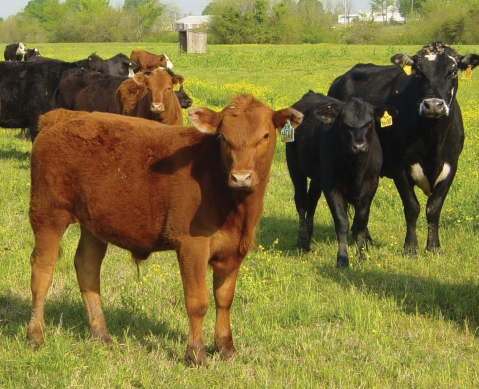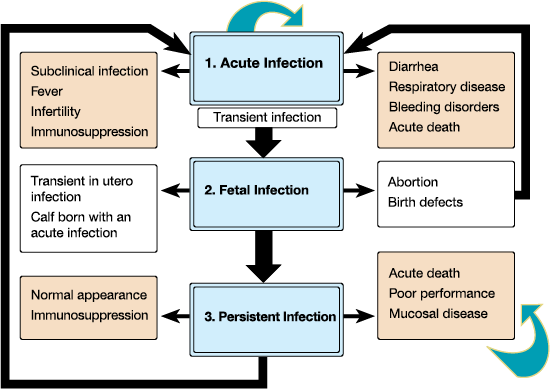What You Should Know about Bovine Viral Diarrhea in Cattle
What is bovine viral diarrhea virus?
Bovine viral diarrhea virus (BVDV) is a potentially serious pathogen that can cause severe economic losses in cattle operations. First identified in 1946 in New York State as a disease causing diarrheal outbreaks and erosive lesions of the digestive tract, BVDV has now been implicated as a cause of many other disease syndromes. It has been estimated that 4–17 percent of farms have one or more persistently infected BVDV calves.

What clinical syndromes are associated with BVDV?
BVDV infections have three clinical syndromes: acute (transient) infection, fetal infection, and persistent infection (PI).
Acute (transient) infections result in fever, depression, diarrhea, respiratory disease, reproductive problems, and more, depending on the age and immune status of the animal infected, as well as the strain of BVDV involved. Abortions can be seen in the cow-calf herd, and respiratory outbreaks are more common in weaned or stocker calves. Most, but not all, animals will recover from acute infections. Some animals show no outward signs of illness (subclinical disease), but the immunosuppressive effects of the virus leave them susceptible to other disease conditions.
Fetal infections can result in abortion; stillborn, weak, or “dummy” calves; or apparently healthy calves. PI calves are created in utero when their dam is exposed to the virus during early gestation. If they survive, infected animals will commonly have poor performance, and younger calves may appear “stunted.” However, PI calves can also appear healthy, making them very difficult to detect.

How is BVDV transmitted?
BVDV does not usually survive in the environment very long (less than 3 weeks), so the most common route of transmission is through direct contact between animals. Acutely infected animals are a temporary source of BVDV transmission to all other animals in the herd.
PI calves are lifelong carriers of the virus and can shed millions of viral particles every day. PI animals serve as a constant source of BVDV exposure in a herd because they continuously shed virus in saliva, mucus, feces, urine, and any other bodily secretion. PI animals, therefore, must be identified and removed from the herd.
How do I test my herd for BVDV?
To test your herd for BVDV, you must submit a tissue sample, usually an ear notch, or a blood sample to a qualified veterinary diagnostic laboratory.
If you suspect a BVDV infection, or if you are concerned about the possibility of PI animals being in your herd, contact your veterinarian. He or she will know which animals to test and what samples to submit for testing.
Prevention and Management
Do not purchase BVDV-infected cattle. Test all replacement animals for BVDV persistent infection before admission to the herd. Isolate all newly purchased cattle for at least 30 days, preferably on another farm.
- Purchase animals only from herds with a known effective vaccination program.
- Make certain your own cattle are properly vaccinated before bringing new cattle into the herd. Consult your herd veterinarian and/or Extension agent when developing a vaccination program.
- Control farm traffic. Do not allow people to enter your farm without wearing clean footwear and clothing.
- Talk to your veterinarian about the Mississippi Voluntary BVD Control Program.
The Mississippi Voluntary BVD Control Program
A cooperative effort between the Mississippi Board of Animal Health (MBAH), the Mississippi State University College of Veterinary Medicine, and the MSU Extension Service has developed the Mississippi Voluntary Bovine Viral Diarrhea Control Program. This program consists of both a Certificate Level and a Participation Level for producers wishing to test their herds for infected animals. The Certificate Level has been developed for producers wishing to maintain a PI-negative BVD herd. The Participation Level has been developed for producers wishing to market PI-BVD negative calves.
This program follows the guidelines of the Uniform Program Standards for the Mississippi Voluntary Bovine Viral Diarrhea Control Program. For more information on BVD or the Mississippi Voluntary BVD Control Program, contact your herd veterinarian. For more information, or contact Dr. Carla Huston, BVD Program Coordinator, at 662-325-1183.
Herd Enrollment
Certification Level
Testing is performed by herd veterinarian
1st Year Requirements:
- Test whole herd
- Submit enrollment forms
- Remove positives
Test every 10-14 months after initial test: test calf crop, replacements, and new additions
- Remove positives
BQA certification and Premise ID registration required
Certificate issued to farm/owner for enrollment in Mississippi Voluntary BVD Control Program
Participation Level
Testing is performed by herd owner or herd veterinarian
Yearly Requirements:
- Test calf crop; also recommend testing heifers that have not calved
- Submit enrollment forms
BQA certification and Premise ID registration required
The information given here is for educational purposes only. References to commercial products, trade names, or suppliers are made with the understanding that no endorsement is implied and that no discrimination against other products or suppliers is intended.
Publication 2480 (POD-12-22)
By Carla Huston, PhD, Professor and Extension Veterinarian, Pathobiology and Population Medicine, College of Veterinary Medicine.
The Mississippi State University Extension Service is working to ensure all web content is accessible to all users. If you need assistance accessing any of our content, please email the webteam or call 662-325-2262.





